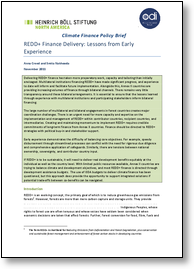REDD+ finance delivery: lessons from early experience
-----------------
Delivering REDD+ finance has taken more preparatory work, capacity and tailoring than initially envisaged. Multilateral institutions financing REDD+ have made significant progress, and experience to date will inform and facilitate future implementation. Alongside this, Annex II countries are providing increasing volumes of finance through bilateral channels. There remains very little transparency around these bilateral arrangements. It is essential to ensure that the lessons learned through experience with multilateral institutions and participating stakeholders inform bilateral financing. The large number of multilateral and bilateral engagements in forest countries creates major coordination challenges. There is an urgent need for more capacity and expertise on the implementation and management of REDD+ within contributor countries, recipient countries, and intermediaries. Creating and maintaining momentum to implement REDD+ requires credible commitments of long-term finance from Annex II countries. Finance should be directed to REDD+ strategies with political buy-in and stakeholder support. Early experience demonstrates the difficulty of balancing core objectives. For example, speedy disbursement through streamlined processes can conflict with the need for rigorous due diligence and comprehensive application of safeguards. Similarly, there are tensions between national ownership, sovereignty, and contributor country input. If REDD+ is to be sustainable, it will need to deliver real development benefits equitably at the individual as well as the country level. With limited public resources available, Annex II countries are trying to balance climate and development objectives, and most REDD+ finance is directed through development assistance budgets. The use of ODA budgets to deliver climate finance has been questioned, but this approach does provide the opportunity to support integrated solutions if potential trade-offs between co-benefits can be navigated.
 Delivering REDD+ finance has taken more preparatory work, capacity and tailoring than initially envisaged. Multilateral institutions financing REDD+ have made significant progress, and experience to date will inform and facilitate future implementation. Alongside this, Annex II countries are providing increasing volumes of finance through bilateral channels. There remains very little transparency around these bilateral arrangements. It is essential to ensure that the lessons learned through experience with multilateral institutions and participating stakeholders inform bilateral financing.
Delivering REDD+ finance has taken more preparatory work, capacity and tailoring than initially envisaged. Multilateral institutions financing REDD+ have made significant progress, and experience to date will inform and facilitate future implementation. Alongside this, Annex II countries are providing increasing volumes of finance through bilateral channels. There remains very little transparency around these bilateral arrangements. It is essential to ensure that the lessons learned through experience with multilateral institutions and participating stakeholders inform bilateral financing.
The large number of multilateral and bilateral engagements in forest countries creates major coordination challenges. There is an urgent need for more capacity and expertise on the implementation and management of REDD+ within contributor countries, recipient countries, and intermediaries. Creating and maintaining momentum to implement REDD+ requires credible commitments of long-term finance from Annex II countries. Finance should be directed to REDD+ strategies with political buy-in and stakeholder support.
Early experience demonstrates the difficulty of balancing core objectives. For example, speedy disbursement through streamlined processes can conflict with the need for rigorous due diligence and comprehensive application of safeguards. Similarly, there are tensions between national ownership, sovereignty, and contributor country input.
If REDD+ is to be sustainable, it will need to deliver real development benefits equitably at the individual as well as the country level. With limited public resources available, Annex II countries are trying to balance climate and development objectives, and most REDD+ finance is directed through development assistance budgets. The use of ODA budgets to deliver climate finance has been questioned, but this approach does provide the opportunity to support integrated solutions if potential trade-offs between co-benefits can be navigated.
---------------

